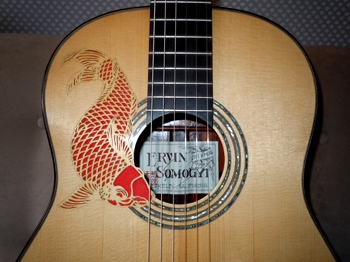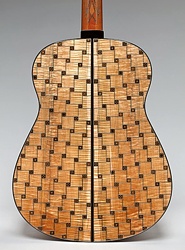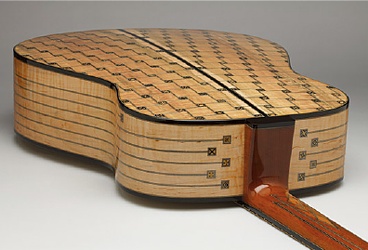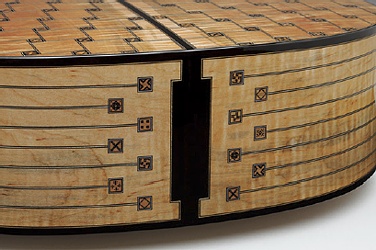Some Thoughts on Guitar Sound
November 3, 2011
The guitar is about many things: craftsmanship, commerce, history, tradition, entertainment, science, wood and gut and a few other things, physics, acoustics, skill, artistry in design and ornamentation, music, marketing and merchandising, magic, etc. Mostly, the guitar is supposed to be about sound. But that thing is the hardest of all the things on this list to pin down and get a measure of.
Sound is air molecules hitting and exciting our ear drums, pure and simple. But there’s no magic at all in this objective description. The magic in musical sound all happens subjectively, in the brain and in how it’s able (through innate ability, training, and acculturation) to processes the neural impulses being sent in from the ear. In this regard sound is very much like food and wine, where the magic happens in one’s own mouth, tongue, palate, nose, eyes, as well as in one’s brain. While many of us report that we “like” this or that sound or wine or food — the fact is that many of us hold these preferences because we’ve learned that we should have them, without ever knowing whether we have any authentic preferences that are different. So when it comes to guitar sound, I’m big on listening and really paying attention. And I recommend it to everyone.
Guitar sound is complex. Good sound is, by definition, sound that pleases the listener — whether he understands anything about the sound or not. A guitar can have any combination or quality of: bass, treble, midrange, resonance, timbre, definition, sustain, projection, dynamic range, warmth, volume, percussiveness, tonal bloom, note shape, harmonics, sweetness, clarity (or lack of it), tonal rise and decay time, cutting power, spareness, evenness of response, brittleness, directionality, separation, brilliance, dryness of tone, tinnyness, tonal darkness or lightness, and/or cleanness of tone. So, unless you have a really sophisticated and practiced ear, it won’t work to evaluate a guitar’s sound by listening to someone play a whole piece of music on it. That amount of information overwhelms the average ear within the first eight or ten bars of the song.
However, there is a way of coming to grips with sound that I stumbled on a few years ago. It is so simple that no one ever thinks of it: that is, really listening to the simplest sounds the guitar can make — and doing it in a quiet place. It’s very much like tasting food or sipping a wine; one does it slowly and without distractions, in order to get a reliable sense of their flavors, textures, sweetness, spicyness, and overall pleasingness. Let me explain what I mean, and my own method; it’ll help you next time you are shopping for a guitar to buy.
What I do (among other things) is to sit down, tune the guitar, and just play a chord. I play it slowly so that I can hear each note separately. And I listen until the sound dies away. I do this more than once. A simple chord can give one a lot of information, especially if one takes one’s time at this. It can also be useful to listen to a second guitar, to compare against. The thing is: the voice of the guitar is the voice of the guitar regardless of what’s being played. But playing a chord, or a few notes, will give you all the information that playing an entire song can give you — without your senses being clogged by any player’s flashy technique. Not that one shouldn’t play whole pieces; but I suggest playing sound-bytes first.
Here’s a checklist for what you can usefully listen for in a six-note chord. If you cannot hear each note [at least somewhat] distinctly, the solution is to keep on listening and learn how to focus your ear. In saying “focus” I mean just that: train your ear to focus on one quality of sound at a time — exactly as you focus on one person’s voice at at time at a well-attended cocktail party. Unless you’re playing a really bad guitar, I guarantee you: the information is all right there. The things to notice are whether or not, or how much, there is of any or all of the following.
- A chord will emerge from the guitar either quickly or slowly;
- notice whether any part of the sound dies off sooner, or lingers longer, than another. This is basic information that you won’t get if someone is playing whole songs;
- listen for basic volume and presence;
- a chord will emerge from the guitar either quickly or slowly;
- listen for some degree of separation: that is, you may be able to hear each note. Or not: the sound may be fuzzy or cloudy and lack focus;
- pay attention to the quality of sound — that is, whether it’s warm, sweet, tinny, rich, live, fundamental, shallow, breathy, open, held back, and/or has lots of overtones;
- is there compliance of response? That is, do you have to push the guitar or does it respond easily to your touch;
- listen to whether the sound is bass-heavy or treble heavy, or well balanced;
- and whether the strength/presence of each string is even;
- and whether there are any wolf tones (i.e., problematically louder or quieter notes)
- and whether the guitar really plays in tune or not;
- and whether the sound is good close-up, and/or from across the room (you’ll need a playing/listening partner for this);
- and whether the guitar sounds different depending on whether you’re listening from in front of it or from off to the side. Some guitars will astonish you with how narrow their area of projection is;
- and whether or not the guitar has good dynamic range; that is, whether can you get different quality of sound from playing very softly, softly, medium, harder, and/or really hard;
- if you repeat these exercises with different chords up and down the neck you’ll get a sense of how evenly (or not) the guitar plays on the whole fingerboard;
- be on the lookout for tonal bloom; that is, whether the sound comes out immediately at full volume or whether it integrates and gets louder before it begins to wane;
- finally, you get to notice and decide whether and how much you like or dislike any of these qualities of tonal response in the guitar you’re playing.All the information is in the soundbox. You just need to know how to listen without having your ear get overwhelmed. And in addition to all these things, you can get a sense whether the guitar is easy or difficult to play; this has nothing to do with sound; it’s about how well the string action, scale length, string spacing, and shape of neck are adapted to your hand.

 Some of you may know that I made a rosewood Andamento guitar about two years ago; it’s a wonder of design and craftsmanship if I do say so myself. The cutting, the inlaying, and the design itself took a long time to execute; and the work also included the design and making of eleven separate rosette logs. It’s the most fancily inlaid thing I’ve ever produced.
Some of you may know that I made a rosewood Andamento guitar about two years ago; it’s a wonder of design and craftsmanship if I do say so myself. The cutting, the inlaying, and the design itself took a long time to execute; and the work also included the design and making of eleven separate rosette logs. It’s the most fancily inlaid thing I’ve ever produced.
